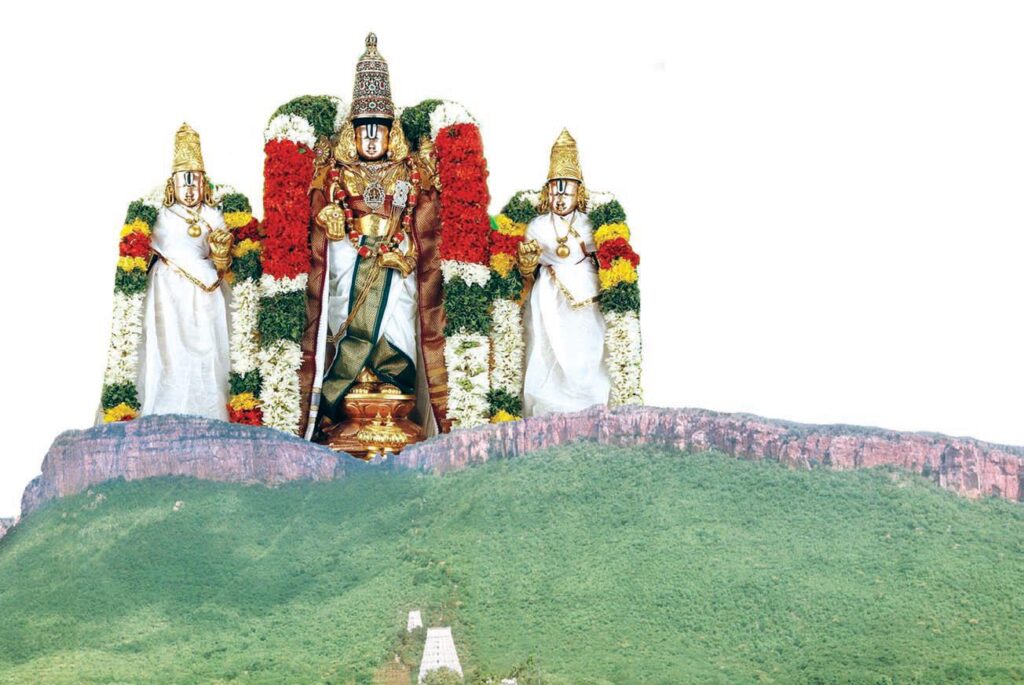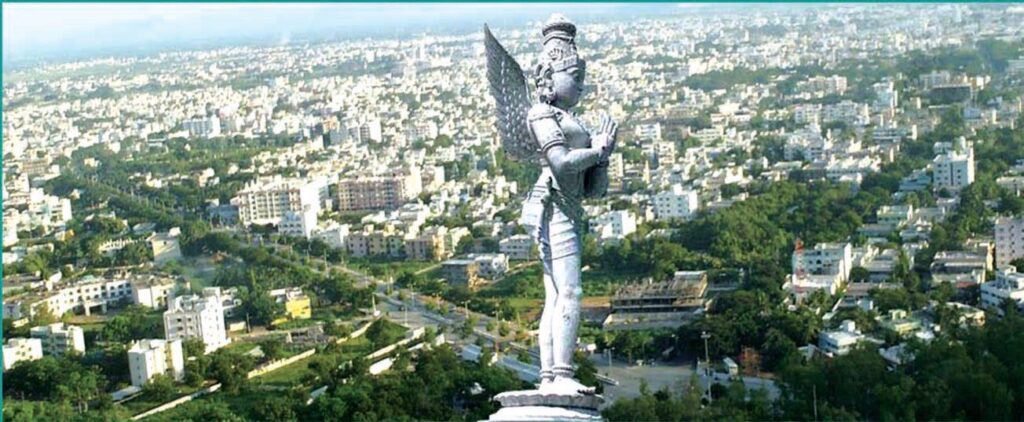Evolution of Tirupati
The divine hills of Tirumala are believed to be directly brought from the celestial Sri Vaikuntam and placed on earth for the benefit of mankind. This holy hill is called ‘Venkatachalam’. Lord Vishnu appeared here in the self-manifested form as ‘Srinivasa’ eons before, worshipped by devotees from all corners of the world.
The village of Tirupati was founded at the foothills of the sacred hills, where Sri Venkateswara blesses all mankind. Tirupati, now a flourishing city has developed into a spiritual, cultural, and educational center because of the unlimited mercy of Sri Venkateswara. That’s why there is an inseparable relation between Tirumala and Tirupati.
There is a wealth of information available about Tirumala hills in Puranas and history books but not much is known about the temple town of Tirupati at the foothills.
Tirupati Balaji Mandir
- North Indian devotees of Lord Balaji refer to the hill shrine as ‘Tirupati Balaji Mandir’.
ThiruppadhiVenkatachalapathy
- The devotees of Tamil Nadu call it ‘ThiruppadhiElumaleyaan’, ’ThiruppadhiVenkatachalapathy’, or ‘Thiruvengadamudaiyaan’,
Tirupathi Thimmappa
- whereas devotees from Karnataka call the deity as ‘Tirupathi Thimmappa’ or ‘Tirupathi Venkata Ramana Devaru’.
Upper Tirupati & Lower Tirupati
Thus Tirumala has always been referred to as ‘Upper Tirupati’ and the town at the foothills ‘Lower Tirupati’. Though the word ‘Tirumala’ has been used for the hill shrine as early as the 10th century as the inscriptions on the temple indicate, devotees have always called it generally ‘Tirupati’. Hence it is quite interesting to discover the etymology of the word ‘Tirupati’ itself, along with the background and history behind the evolution of the temple town.
The ‘rig veda’, the most ancient of the Vedas, contains an interesting mantra, in its 10th mandala that speaks of the Venkatachala hill and refers to it as ‘Vikata’ (a colloquial form of Venkata). In the year 1801, the East India Company assumed direct control over the management of Tirumala Temple.
General Stratton – Report on Tirumala temple
The British Government appointed an officer ‘General Stratton’, the then collector of Chittoor, to submit a detailed report on the workings of the Tirumala Venkateswara Temple. On the 31st of January, 1803, Stratton submitted a report on the most ancient and prominent temple. General Stratton, in his report, refers to the Tirumala hills as ‘Tripatty hills’, the holy shrine as ‘Tripatty Pagoda’, and the village at the foothills recorded as ‘Tripatty village’.

There is another interesting observation that is quite surprising. It is a well-known fact that the worship and religious rituals performed at the Tirumala temple are conducted according to the strict tenets of Vaikhanasa agama.
Sri Venkatesa Gayatri Mantra that is recited by the Vaikhanasa priests during worship to the presiding deity goes-
Om Vemkatesayavidmahe tripathinadhayadhimahi | Tannahsrinivasa: prachodayat ||
- Incidentally, the Sanskrit word ‘Tripathi’ in this mantra coincides with the colloquial ‘Tripatty’ as referred to by the British officer. There are several meanings to the word ‘Tripathinatha’ –
- ‘Tripathi’ means the sacred Venkatachala hill and ‘Tripathinatha’ means the presiding deity, Sri Venkateswara.
- ‘Tripatha’ represents the three worlds – Swargaloka, Bhuloka, and PatalaLoka. Lord Venkateswara is the ruler of these three worlds.
- Based on Puranic accounts, ‘Tripatha’ also indicates that the sacred hill shrine was placed on the Northern banks of river Swarnamukhi where it confluences along with its tributaries Bhima and Kalyani. It is on the same tributary that the famous Kalyani dam has been constructed.
- ‘Tripatha’ also suggests that there were three routes that were frequently used to reach the hill shrine of Vengadam, since ancient times.
- Devotees coming to worship Lord Venkateswara from the west i.e., from Karnataka, reach Tirumala through the ‘Srivari Mettu’ footpath near Chandragiri. It is also called ‘Sreepathivari Mettu’.
- Devotees coming from the South i.e. from Tamilnadu reach Tirumala from the regular Alipiri footpath.
- Devotees coming from the northern part of Andhra, Maharashtra, and northern parts of India, reach Tirumala to worship Srivaru through the ‘Annamayya’ pathway. It begins near Rajampet of Kadapa district and stretches along the Mamandur forest range, passing through the Tumburukona, the valley near Tumburuteertham, and finally reaching Tirumala near PapavinasanaTheertham. The famous saint poet Tallapaka Annamacharya is said to have gone to Tirumala through this route to worship Srivaru and hence the same is named after him.

SriSaIla – ThiruMalai (Tirumala)
Tirumala was always called by the names ‘Tripati’ and ‘Tirupati’. Sri Venkatachala Mahatyam signifies that Tirumala is called ‘SriSaIla’ – ‘Sri’ implies ‘thiru’ in Tamil and ‘SaIla’ means mountain – ‘malai’ in Tamil. So SriSaIla came to be popularly known as “Tirumala”. But the word ‘Tripati’ which is part of the ancient Venkatesa Gayatri mantra, stood the test of time as ‘Tirupati’ and became permanent.
“What is a name?” might be the general question; but here in this case, it represents the devotion of millions of devotees for Sri Venkateswara. For devotees, a mere chanting and utterance of the name ‘Tirupati’, instills a divine feeling and they are instantly transported to the sanctum of Tirumala. Upon hearing the same, they are immediately immersed in thoughts of the divine grace of Srivaru.
Tirupati always reminds them that their beloved presiding deity, Sri Srinivasa, is always there for them, to hear their woes and bless them with what is good for them.

